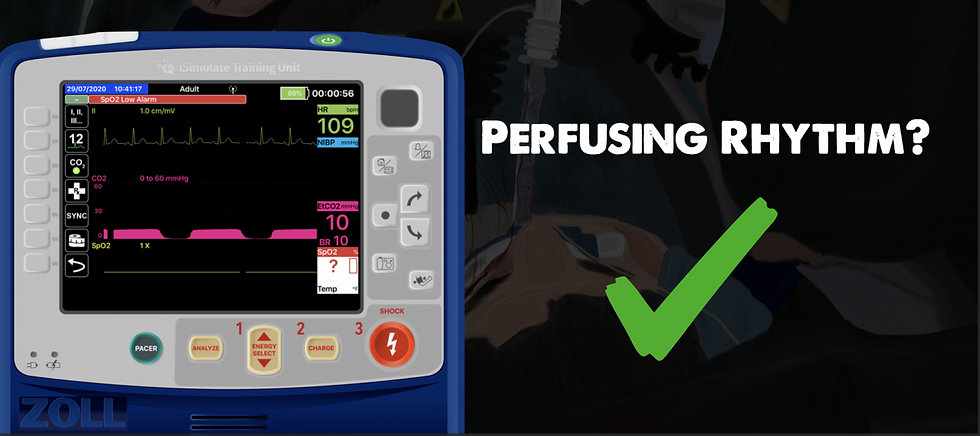Ultrasound Guided Cardiac Arrest (case 1)
- Tyer Christifulli
- Sep 10, 2020
- 3 min read

As Mike sits down with his crew at the firehouse, he mentions how eye opening the utilization of ultrasound in cardiac arrest has been. You see, Mike works as a career firefighter/paramedic, but he also pulls shifts as a part-time flight medic for a program that is one year into their adoption of point of care ultrasound (POCUS). Mike would love nothing more than to see his med unit at the fire department adopt ultrasound as well. However, there are two things people in EMS/Fire hate - change, and the way things are.

"Mike, I love you man - but you are literally one of the biggest nerds I know. I can just see you now replacing that stethoscope you wear around your neck with an ultrasound probe!

As he smirks and finishes his last few bites, Mike says, "I will tell you three situations just last month where I was able to make a clinical decision based on purely my ability to see what the heart is doing, as opposed to guessing."

Case 1
It was just about two weeks ago when my flight team was paged out to a car vs. tree with CPR in progress. We jumped in the back of the med unit to find a middle aged man receiving compressions by a LUCAS device. The crew mentioned he was in a PEA and they had already given three rounds of epinephrine. They were very much-so in the ACLS vortex.

They mentioned that they were coming up on a rhythm check, so I grabbed my ultrasound unit from my flight suit pocket and placed it just below the xiphoid process with the probe marker (a little marking on the probe) in the three o' clock position. "Ok, I need someone to start counting down from 10 when we stop compressions. When we hit 10, if we don't feel a pulse, we will continue compressions."

As the rhythm check approached, my probe was placed and I was all set to record a clip.
Recording allows you to give a more detailed analysis of the image when it is not at the expense of interupting chest compressions. As the LUCAS is paused, you can't help but notice that you have a perfusing rhythm.

We know that a perfusing rhythm in the absense of a pulse has always been classfied as PEA, right? Well get this! The subxiphoid view of the heart shows movement! I don't see any tamponade and as far as I am concerned we have ROSC.
The medic up at the head has a hand on the carotid artery and says," I don't feel a pulse. We need to restart compressions."
His partner speaks up and says: "man, why are we doing compressions on a guy whose heart is beating perfectly fine? Shouldn't we be like looking for other causes of hypotension besides his heart?"
Mike looks up at the guys eating lunch and asks:

"Well duh, he is in PEA," says the probationary firefighter who has been listening intently from the kitchen. Mike see's this has an awesome teaching opporunity and walks over to the whiteboard hanging in the dining area. He erases the fantasy football rankings and writes two words, PRESS & PREM.

"You see as Forest Gump would say: 'PEA is like a box of chocoloates, you never know what you're gonna get.' There are two types of cardiac activity that may present with a perfusing rhythm on ECG."
PRESS: Perfusing Rhythm w/ Echocardio Stand Still
PREM: Perfusing Rhythm w/ Echocardio Motion
If the rhythm is perfusing and the heart is beating, there is no need to perform external compressions. Your time is better spent searching for reversible causes. However, if the heart is not beating, chest compressions are absolutley indicated in order to build up enough coronary perfusion to obtain ROSC. Mike sketches out his mental model of how he approaches a traumatic arrest.

We removed the LUCAS (get's in the way of the procedures), placed a pelvic binder, performed bilateral finger thoracostomy's and ran whole blood through the humeral head IO.

We ended up getting a pulse back before arriving at the trauma center. What's scary though is thinking this dude could have just as easily got stuck in the ACLS vortex of epi and compressions.

It appears Mike has his work cut out for him before he gets colleague buy-in. Join us next time as Mike discusses a medical case of why ultrasound convinced him to shock asystole. 😬
Special shout out to Austin Quillet for the awesome artwork, Chris Kroboth/iSimulate for the monitor screen shots, and Philips Lumify for all their support.
Further Reading:
Smith, J. E., Rickard, A., & Wise, D. (2015). Traumatic cardiac arrest. Journal of the Royal Society of Medicine, 108(1), 11–16. https://doi.org/10.1177/0141076814560837










Comments